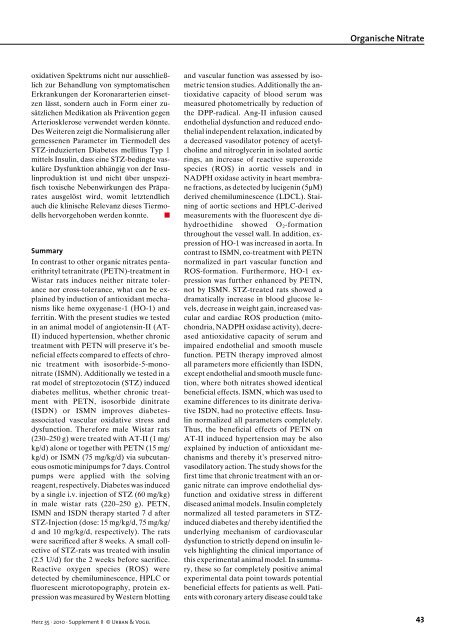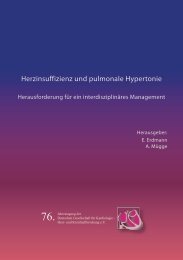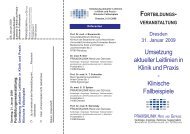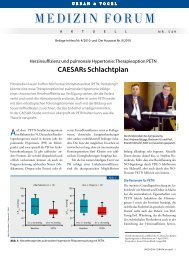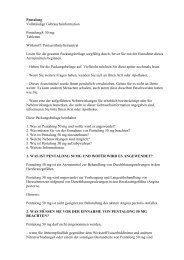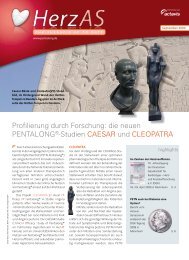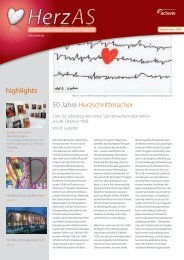HerzSupplement - Pentalong von Actavis
HerzSupplement - Pentalong von Actavis
HerzSupplement - Pentalong von Actavis
Sie wollen auch ein ePaper? Erhöhen Sie die Reichweite Ihrer Titel.
YUMPU macht aus Druck-PDFs automatisch weboptimierte ePaper, die Google liebt.
oxidativen Spektrums nicht nur ausschließlich<br />
zur Behandlung <strong>von</strong> symptomatischen<br />
Erkrankungen der Koronararterien einsetzen<br />
lässt, sondern auch in Form einer zusätzlichen<br />
Medikation als Prävention gegen<br />
Arteriosklerose verwendet werden könnte.<br />
Des Weiteren zeigt die Normalisierung aller<br />
gemessenen Parameter im Tiermodell des<br />
STZ-induzierten Diabetes mellitus Typ 1<br />
mittels Insulin, dass eine STZ-bedingte vaskuläre<br />
Dysfunktion abhängig <strong>von</strong> der Insulinproduktion<br />
ist und nicht über unspezifisch<br />
toxische Nebenwirkungen des Präparates<br />
ausgelöst wird, womit letztendlich<br />
auch die klinische Relevanz dieses Tiermodells<br />
hervorgehoben werden konnte. n<br />
Summary<br />
In contrast to other organic nitrates pentaerithrityl<br />
tetranitrate (PETN)-treatment in<br />
Wistar rats induces neither nitrate tolerance<br />
nor cross-tolerance, what can be explained<br />
by induction of antioxidant mechanisms<br />
like heme oxygenase-1 (HO-1) and<br />
ferritin. With the present studies we tested<br />
in an animal model of angiotensin-II (AT-<br />
II) induced hypertension, whether chronic<br />
treatment with PETN will preserve it’s beneficial<br />
effects compared to effects of chronic<br />
treatment with isosorbide-5-mononitrate<br />
(ISMN). Additionally we tested in a<br />
rat model of streptozotocin (STZ) induced<br />
diabetes mellitus, whether chronic treatment<br />
with PETN, isosorbide dinitrate<br />
(ISDN) or ISMN improves diabetesassociated<br />
vascular oxidative stress and<br />
dysfunction. Therefore male Wistar rats<br />
(230–250 g) were treated with AT-II (1 mg/<br />
kg/d) alone or together with PETN (15 mg/<br />
kg/d) or ISMN (75 mg/kg/d) via subcutaneous<br />
osmotic minipumps for 7 days. Control<br />
pumps were applied with the solving<br />
reagent, respectively. Diabetes was induced<br />
by a single i.v. injection of STZ (60 mg/kg)<br />
in male wistar rats (220–250 g). PETN,<br />
ISMN and ISDN therapy started 7 d after<br />
STZ-Injection (dose: 15 mg/kg/d, 75 mg/kg/<br />
d and 10 mg/kg/d, respectively). The rats<br />
were sacrificed after 8 weeks. A small collective<br />
of STZ-rats was treated with insulin<br />
(2.5 U/d) for the 2 weeks before sacrifice.<br />
Reactive oxygen species (ROS) were<br />
detected by chemiluminescence, HPLC or<br />
fluorescent microtopography, protein expression<br />
was measured by Western blotting<br />
Herz 35 · 2010 · Supplement II © Urban & Vogel<br />
and vascular function was assessed by isometric<br />
tension studies. Additionally the antioxidative<br />
capacity of blood serum was<br />
measured photometrically by reduction of<br />
the DPP-radical. Ang-II infusion caused<br />
endothelial dysfunction and reduced endothelial<br />
independent relaxation, indicated by<br />
a decreased vasodilator potency of acetylcholine<br />
and nitroglycerin in isolated aortic<br />
rings, an increase of reactive superoxide<br />
species (ROS) in aortic vessels and in<br />
NADPH oxidase activity in heart membrane<br />
fractions, as detected by lucigenin (5µM)<br />
derived chemiluminescence (LDCL). Staining<br />
of aortic sections and HPLC-derived<br />
measurements with the fluorescent dye dihydroethidine<br />
showed O2-formation<br />
throughout the vessel wall. In addition, expression<br />
of HO-1 was increased in aorta. In<br />
contrast to ISMN, co-treatment with PETN<br />
normalized in part vascular function and<br />
ROS-formation. Furthermore, HO-1 expression<br />
was further enhanced by PETN,<br />
not by ISMN. STZ-treated rats showed a<br />
dramatically increase in blood glucose levels,<br />
decrease in weight gain, increased vascular<br />
and cardiac ROS production (mitochondria,<br />
NADPH oxidase activity), decreased<br />
antioxidative capacity of serum and<br />
impaired endothelial and smooth muscle<br />
function. PETN therapy improved almost<br />
all parameters more efficiently than ISDN,<br />
except endothelial and smooth muscle function,<br />
where both nitrates showed identical<br />
beneficial effects. ISMN, which was used to<br />
examine differences to its dinitrate derivative<br />
ISDN, had no protective effects. Insulin<br />
normalized all parameters completely.<br />
Thus, the beneficial effects of PETN on<br />
AT-II induced hypertension may be also<br />
explained by induction of antioxidant mechanisms<br />
and thereby it’s preserved nitrovasodilatory<br />
action. The study shows for the<br />
first time that chronic treatment with an organic<br />
nitrate can improve endothelial dysfunction<br />
and oxidative stress in different<br />
diseased animal models. Insulin completely<br />
normalized all tested parameters in STZinduced<br />
diabetes and thereby identified the<br />
underlying mechanism of cardiovascular<br />
dysfunction to strictly depend on insulin levels<br />
highlighting the clinical importance of<br />
this experimental animal model. In summary,<br />
these so far completely positive animal<br />
experimental data point towards potential<br />
beneficial effects for patients as well. Patients<br />
with coronary artery disease could take<br />
Organische Nitrate<br />
43


